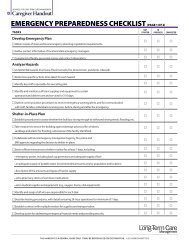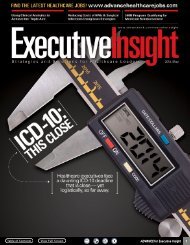1 ADVANCE for Executive Insight
1 ADVANCE for Executive Insight
1 ADVANCE for Executive Insight
- No tags were found...
You also want an ePaper? Increase the reach of your titles
YUMPU automatically turns print PDFs into web optimized ePapers that Google loves.
cover STORY<br />
Hospitals and other providers need to quantify and<br />
understand the way costs are incurred <strong>for</strong> patient<br />
care and be aware of alternatives.<br />
COST TRANSPARENCY<br />
Much of the rapid escalation in healthcare costs<br />
can be attributed to providers’ lack of awareness<br />
as to the real costs of delivering patient care. To<br />
stay competitive, healthcare organizations need<br />
to streamline inefficient processes and fully understand<br />
resource requirements. Ultimately,<br />
the value proposition should maximize patient<br />
outcomes at the least cost. This goes way beyond<br />
having an accurate cost accounting system,<br />
although that is important. Cost transparency<br />
can be improved through proven techniques, including<br />
Activity Based Management (ABM) and<br />
Comparative Cost Effectiveness (CCE).<br />
Activity Based Management (ABM)<br />
ABM is an approach to cost management used<br />
across industries that aims to maximize valueadd<br />
activities while minimizing or eliminating<br />
non value-add activities. For healthcare, this<br />
means analyzing activities and related costs to<br />
ensure they contribute to quality patient care<br />
while eliminating or reducing non-supportive,<br />
unproductive costs. Instead of focusing on broad<br />
expense categories (i.e., what is spent), the focus<br />
is on activities that take place (i.e., what is done).<br />
ABM can be deployed in both administrative<br />
and clinical departments to identify where costs<br />
are excessive, ineffective or not well understood.<br />
Adoption of ABM in healthcare has been<br />
hindered by a general lack of understanding of<br />
the benefits along with misperceptions that it<br />
is more expensive and complex to deploy. Certainly<br />
it is more difficult to apply in the healthcare<br />
world, where patient care considerations<br />
generally trump cost considerations. However,<br />
the value of being able to better manage financial<br />
results far outweighs the ef<strong>for</strong>t of deployment.<br />
Comparative Cost Effectiveness (CCE)<br />
CCE is a cost evaluation technique that focuses<br />
on existing alternatives <strong>for</strong> care delivery. CCE<br />
is often used with episode of care costing, particularly<br />
with regard to the choice of clinical<br />
treatment plans <strong>for</strong> the more costly diagnoses/<br />
treatments/procedures. This approach fully considers<br />
the combined cost of care (including pharmaceuticals,<br />
devices, technology, physicians and<br />
hospital costs), and compares it to the outcomes<br />
achieved during the entire episode of patient<br />
care. As we face a future with bundled payments<br />
that will <strong>for</strong>ce us to look more deeply at costs as<br />
a function of cross-continuum care coordination,<br />
this kind of approach is becoming critical.<br />
Hospitals and other providers need to quantify<br />
and understand the way costs are incurred <strong>for</strong><br />
patient care and be aware of alternatives. CCE<br />
is a complex process requiring systems to generate<br />
the right analytical data as well as qualified<br />
personnel who can consolidate and interpret the<br />
data. Most healthcare providers are not set up<br />
to gather this data and manufacturers have been<br />
reluctant to provide such in<strong>for</strong>mation.<br />
Studies have shown that the most expensive<br />
alternatives do not necessarily provide the best<br />
clinical outcomes. Managed care companies are<br />
very focused on this reality. Interestingly, parts of<br />
Europe have been incorporating this analysis into<br />
their healthcare organizations <strong>for</strong> many years and<br />
consider it a major component of limiting healthcare<br />
spending; it has been accepted and embraced<br />
as a necessity. That contrasts to the U.S.,<br />
where the medical community here has not been<br />
as supportive of including cost considerations in<br />
clinical decisions. Certainly medical device and<br />
pharmaceutical manufacturers are not wholly<br />
supportive — much of their focus is on preserving<br />
their own income. CCE focusing on episodes<br />
of care is needed to balance improved bottom<br />
line per<strong>for</strong>mance with the best clinical outcomes.<br />
LABOR MANAGEMENT<br />
Any discussion of cost containment in healthcare<br />
has to include the cost of labor. Labor costs<br />
are over 50% of revenues in most not-<strong>for</strong>-profit<br />
hospitals and are regularly over 80% of medical<br />
practice costs. Yet, <strong>for</strong>-profit hospital systems<br />
report labor cost averages of as low as 40% of<br />
revenues. Simple math reveals that a provider<br />
with $100 million of revenue would experience<br />
bottom line improvement of $1 million <strong>for</strong> every<br />
1% improvement in this ratio. As described earlier,<br />
accountability and activity-based management<br />
are key components of controlling labor<br />
costs. How is this done on a tactical level? Here<br />
16 <strong>ADVANCE</strong> <strong>for</strong> <strong>Executive</strong> <strong>Insight</strong>









